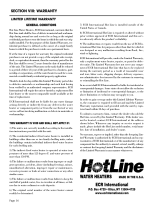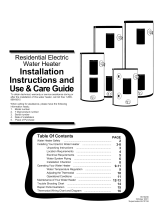
17
PN 615000229 REV. E [04/01/2021]
Temperature Pressure Relief Valve Installation:
• Install discharge line so water discharged from the temperature and pressure relief valve exits within 6" six inches
above, or any distance below, the structural oor.
• Install temperature Pressure valve so discharge shall not contact any live electrical part.
• Install temperature pressure valve as shown in Figure 13.
• Do not install a valve or shuto device between tank and temperature pressure valve.
• Install discharge line to allow for complete drainage of both temperature pressure relief valve and the discharge
line.
• Discharge opening must not be subjected to blockage or freezing.
• Size and arrange discharge piping to avoid reducing Temperature Pressure Valve relieving capacity below minimum
relief valve capacity.
• Run pipe as short and straight as possible to location protecting user from scalding and properly drain piping.
• Terminate pipe with plain end (not threaded).
• Do not thread, plug, or cap discharge line.
• Maintain minimum clearance of four (4) inches on side of water heater for servicing and maintenance of
temperature pressure valve
4. Boiler Water Pipe Installation
Installation procedure for pipes and components for boiler water ow.
1.
Determine where the boiler, space heating, and water heater connections should be made based on the type of piping
system that is either in-place or is to be installed for a new hydronic system installation.
2.
It is manufacturer recommended that 1”, or larger, pipe be installed for boiler between indirect tank and the hot water
boiler. If boiler water through the indirect tank coil is controlled by a zone valve, a 1” zone valve is recommended.
3.
Central Heating Zone Pump System. For a system using central heating zone pumps, the water heater connection
labeled “BOILER SUPPLY” should be piped to the boiler supply piping after the air eliminator and before the space
heating takeos. Mount the water heater circulator as close as possible to the water heater, and make sure the ow
arrow points toward the water heater. The use of shut-o valves is recommended for future service convenience. The
water heater connection labeled “BOILER RETURN” should be piped to the boiler return piping as close to the boiler
as possible and after any ow control or check valves in the space heating return piping. The use of a union and a
shut-o valve is manufacturer recommended. Use of a check valve is required to prevent back ow through the water
heater during operation of the space heating system.
4.
Central Heating Zone Valve System. For a space heating system that uses Zone Valves, refer to Figure 4. Replace
zone circulators with valves. The water heater connection labeled “BOILER SUPPLY” should be piped to the boiler
supply piping after the air eliminator and before the Central Heating system pump. Mount the water heater circulator
as close as possible to the water heater, and make sure the ow arrow points toward the water heater. The use of a
shut-o valve is recommended for future service convenience. The water heater connection labeled “BOILER RETURN”
should be piped to the boiler return piping as close to the boiler as possible and after any ow control or check valves
in the space heating return piping. The use of a union and a shut-o valve is recommended. The use of a check valve
is required to prevent back ow through the indirect water heater during operation of the space heating.
NOTICE
When installing pipes and ttings on the threaded connections on the indirect water heater, all soldered
joints shall be a minimum of four inches away from the indirect water heater to provide enough room for the
soldering process. Any damages on the tank cover and insulation material are not covered by warranty.
WARNING
Burn and Scald Hazard. Temperature pressure relief valve could discharge steam or hot water during
operation. Install discharge piping per the instructions given below.
!























